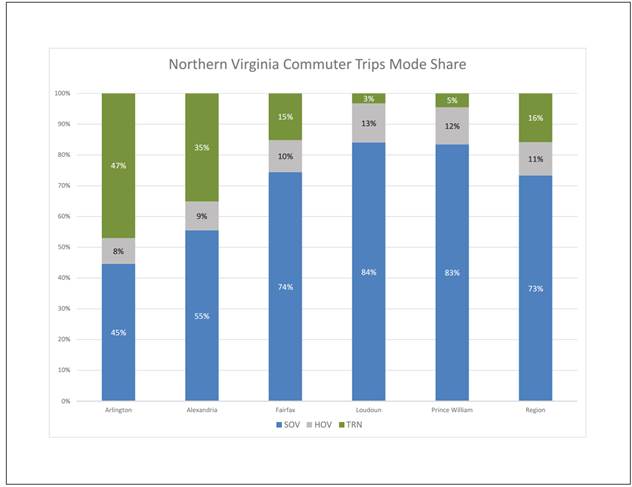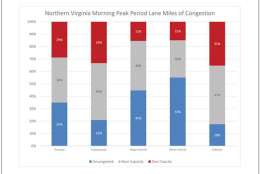









WASHINGTON — Most major roads in Northern Virginia are congested at rush hour, with more than one-third of the lane-miles “over capacity,” according to the first part of a study by the Northern Virginia Transportation Commission.
During the morning rush, roads such as the Fairfax County Parkway — like highways for long stretches, but with some intersections with traffic lights — are among the most congested roads. The study classifies them as expressways, and says 33 percent of their lane-miles are over capacity, and 46 percent near capacity.
Collector roads are even more likely to be congested, with 35 percent over capacity and 47 percent near capacity.
Freeways, such as Interstate 66, are the third-most congested type of road in the morning, when 65 percent the lane-miles are either over capacity or near capacity.
Fairfax County has the largest portion of its roads near (41 percent) and over (23 percent) capacity during the morning rush, just ahead of Alexandria, which has fewer lane-miles near capacity.
Prince William County and Loudoun County are nearly equal on congestion in the morning, with more uncongested roadway than Fairfax or Alexandria. Arlington is tied with Loudoun, with 49 percent of lane-miles uncongested, but Arlington has a slightly higher portion of roadway over capacity.
The NVTC is setting the baseline for a broader study meant to examine the economic impact of Metro and Virginia Railway Express. Eventually, the study will attempt to show how much less development there would be in the region — or how much more sprawling that development would be — without the rail systems if the region just wanted to prevent traffic from getting worse than it is today.
Driving alone remains by far the most common way of commuting in Northern Virginia, accounting for 73 percent of all commuters’ trips. In Loudoun and Prince William counties, more than 80 percent of commuting trips are people driving alone. In Fairfax County, 74 percent; in Alexandria, 55 percent; and in Arlington, 45 percent.
Out of those jurisdictions, only in Arlington is it more likely to find a commuter taking transit than driving alone, with 47 percent of commuters using transit. Alexandria has the second-highest transit usage for commutes at 35 percent.
Of the 16 percent of Northern Virginians who take transit on their commutes, about 23 percent take only a bus, while 77 percent take a train for at least part of their trips.
In Loudoun County, only 3 percent of commuting trips are on transit, but Loudoun commuters have the highest level of carpooling in the region at 13 percent, just ahead of Prince William County. About 11 percent of commuters across the region carpool to work.
Arlington residents have the shortest average commute distance of the jurisdictions, at 9.6 miles. Loudoun and Prince William County residents have the longest average commute distances — 19.65 and 19.37 miles, respectively. Overall, the average Northern Virginia commute is 15.45 miles.
Non-work trips tend to be much shorter and more consistent across the region with a range in the average from 4.98 miles in Prince William County to 6.2 miles in Fairfax County.







